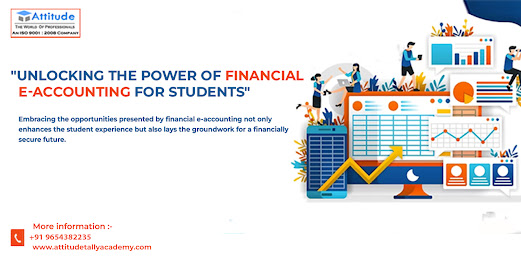Unlocking the Power of Financial E-Accounting for Students
Introduction
In an era dominated by digital dynamics, the
significance of financial literacy has never been more pronounced, especially
for students juggling the intricacies of education, personal expenses, and
future planning. This blog delves into the transformative capacities of
financial e-accounting, shedding light on how it empowers students to
efficiently manage their finances and achieve a heightened level of financial efficiency.
Decoding Financial E-Accounting
Often referred to as electronic accounting,
financial e-accounting involves harnessing digital tools and software to
streamline financial processes. This contemporary approach to accounting offers
students a streamlined and effective method to monitor their income, expenses,
and overall financial well-being. By tapping into technology, students can
access real-time insights into their financial status, fostering more informed
decision-making.
Strategies for Student Money Management
The challenge of balancing tuition fees, living
costs, and social activities within a constrained budget is a common hurdle for
students. Financial e-accounting tools come to the rescue, equipped with
features like budget tracking, expense categorization, and tools for setting
and achieving financial goals.
Optimizing Budget Tracking
Financial e-accounting tools empower students to
effortlessly create and monitor budgets. By inputting income sources and
setting spending limits across categories like groceries, entertainment, and
transportation, students gain a comprehensive understanding of their financial
flow. This not only encourages mindful spending but also acts as a preventative
measure against financial strain.
Streamlining Expense Categorization
A standout feature of financial e-accounting lies
in its ability to automatically categorize expenses. This feature simplifies
the tracking process, freeing up valuable time for students to focus on
academics and extracurricular pursuits. Categorization also paints a holistic
picture of spending patterns, aiding students in identifying areas where
cost-cutting or increased allocations can be implemented.
Navigating Financial Goals
Whether saving for textbooks, a study abroad
adventure, or post-graduation plans, financial e-accounting tools prove
invaluable for students in setting and attaining their financial goals. By
establishing practical objectives and monitoring progress over time, students
cultivate a disciplined approach to financial management, laying the groundwork
for sustained financial stability.
Enhancing Financial Efficiency
The integration of financial e-accounting into a
student's routine contributes to financial efficiency in various dimensions:
Time Efficiency: Automated financial tasks reduce the time invested in manual data entry
and calculations, enabling students to channel their focus towards academic and
personal endeavors.
Accuracy Assurance: Digital tools minimize the risk of human error,
ensuring financial records are precise and dependable—an essential factor for
making well-informed financial decisions.
Anytime, Anywhere Accessibility: Cloud-based e-accounting platforms grant students
access to their financial information at their convenience. This accessibility
augments flexibility, providing convenience and control.
Conclusion:
Unveiling the potential of financial e-accounting
emerges as a pivotal strategy for students striving to master the art of money management and attain financial efficiency. By embracing
these digital tools, students not only seize control of their finances but also
cultivate responsible spending habits, working steadfastly towards their
financial aspirations. The adoption of financial e-accounting not only enhances
the overall student experience but also sets the stage for a financially secure
future.




Comments
Post a Comment